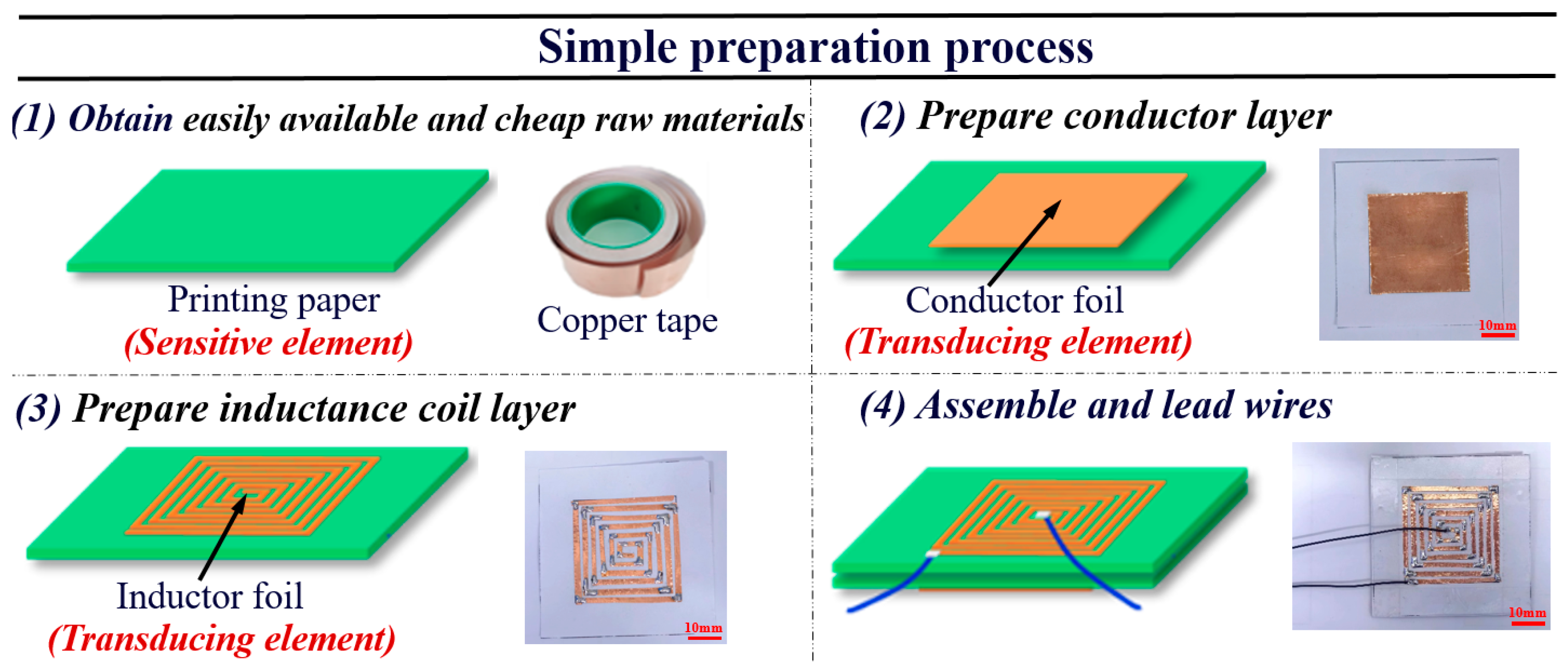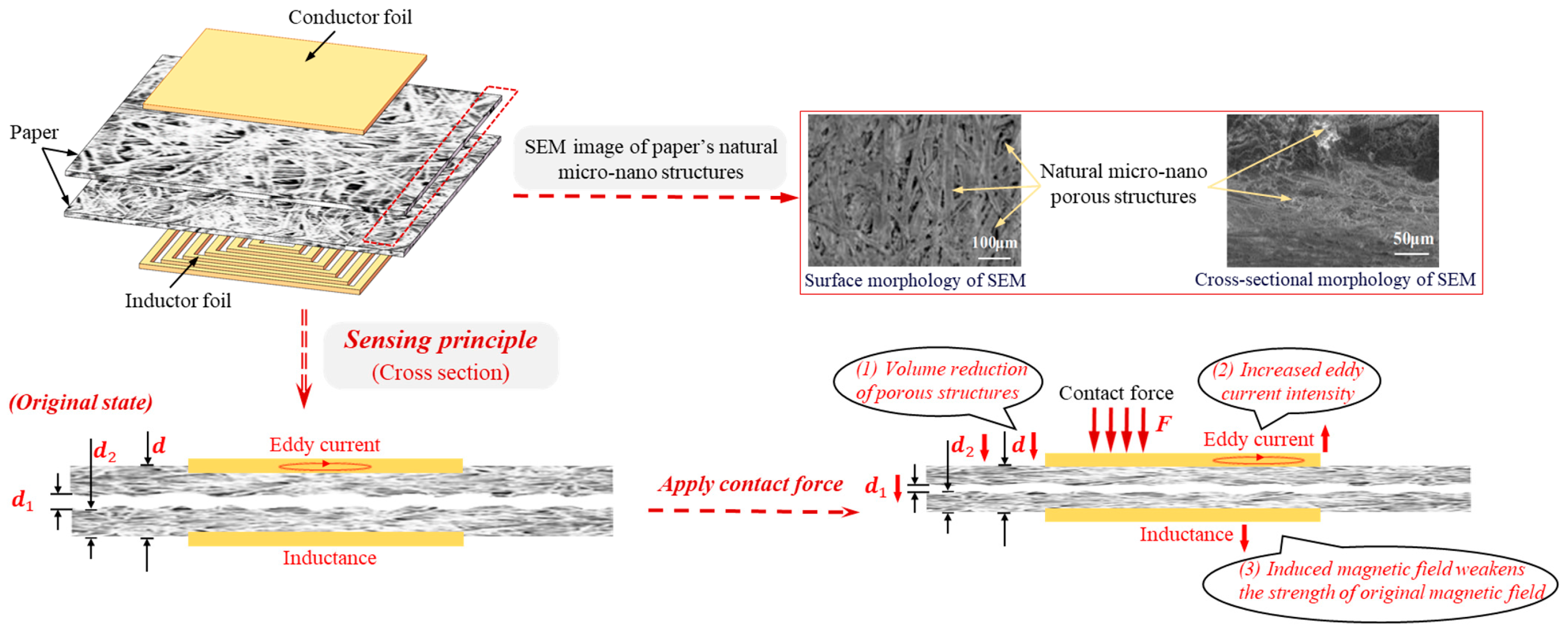Inductive Paper-Based Flexible Contact Force Sensor Utilizing Natural Micro-Nanostructures of Paper: Simplicity, Economy, and Eco-Friendliness
Abstract
:1. Introduction
2. Device Fabrication
3. Results and Discussion
3.1. Sensing Principle and Micro-Nanostructure Characterization
3.2. Sensor Performance Testing
3.3. Sensor Performance Optimization
3.4. Application of Sensors in Human Motion and Respiratory Monitoring
4. Conclusions
Author Contributions
Funding
Data Availability Statement
Conflicts of Interest
References
- Yeh, S.K.; Hsieh, M.L.; Fang, W.L. CMOS-Based Tactile Force Sensor: A Review. IEEE Sens. J. 2021, 21, 12563–12577. [Google Scholar] [CrossRef]
- Lu, Y.Y.; Kong, D.P.; Yang, G.; Wang, R.H.; Pang, G.Y.; Luo, H.Y.; Yang, H.Y.; Xu, K.C. Machine Learning-Enabled Tactile Sensor Design for Dynamic Touch Decoding. Adv. Sci. 2023, 10, 2303949. [Google Scholar] [CrossRef] [PubMed]
- Chen, Y.W.; Pancham, P.P.; Mukherjee, A.; Martincic, E.; Lo, C.Y. Recent advances in flexible force sensors and their applications: A review. Flex. Print. Electron. 2022, 7, 033002. [Google Scholar] [CrossRef]
- Sun, M.W.; Cui, S.Y.; Wang, Z.Z.; Luo, H.Y.; Yang, H.Y.; Ouyang, X.P.; Xu, K.C. A laser-engraved wearable gait recognition sensor system for exoskeleton robots. Microsyst. Nanoeng. 2024, 10, 50. [Google Scholar] [CrossRef] [PubMed]
- Wang, H.B.; Jones, D.; de Boer, G.; Kow, J.; Beccai, L.; Alazmani, A.; Culmer, P. Design and Characterization of Tri-Axis Soft Inductive Tactile Sensors. IEEE Sens. J. 2018, 18, 7793–7801. [Google Scholar] [CrossRef]
- Yang, Q.Q.; Ye, Z.Q.; Wu, R.K.; Lv, H.H.; Li, C.; Xu, K.C.; Yang, G. A Highly Sensitive Iontronic Bimodal Sensor with Pressure-Temperature Discriminability for Robot Skin. Adv. Mater. Technol. 2023, 8, 2300561. [Google Scholar] [CrossRef]
- Bayer, I.S. MEMS-Based Tactile Sensors: Materials, Processes and Applications in Robotics. Micromachines 2022, 13, 2051. [Google Scholar] [CrossRef] [PubMed]
- Rim, Y.S.; Bae, S.H.; Chen, H.J.; De Marco, N.; Yang, Y. Recent Progress in Materials and Devices toward Printable and Flexible Sensors. Adv. Mater. 2016, 28, 4415–4440. [Google Scholar] [CrossRef] [PubMed]
- Chang, H.; Kim, S.; Jin, S.; Lee, S.-W.; Yang, G.-T.; Lee, K.-Y.; Yi, H. Ultrasensitive and highly stable resistive pressure sensors with biomaterial-incorporated interfacial layers for wearable health-monitoring and human–machine interfaces. ACS Appl. Mater. Interfaces 2018, 10, 1067–1076. [Google Scholar] [CrossRef] [PubMed]
- Chen, S.C.; Wang, Y.F.; Yang, L.; Guo, Y.J.; Wang, M.; Sun, K. Flexible and transparent sensors with hierarchically micro-nano texture for touchless sensing and controlling. Nano Energy 2021, 82, 105719. [Google Scholar] [CrossRef]
- An, N.L.; Qin, J.X.; Zhou, X.; Wang, Q.D.; Fang, C.Q.; Guo, J.P.; Nan, B. Recent Progress in Cellulose-Based Flexible Sensors. J. Renew. Mater. 2022, 10, 2319–2334. [Google Scholar] [CrossRef]
- Lu, S.; Ma, J.; Ma, K.; Wang, S.; Yang, X.; Wang, X.; Tang, H. Low-cost, highly sensitive and stable pressure sensor based on glass fiber surfacing mat coated with graphene. Funct. Mater. Lett. 2020, 13, 2051002. [Google Scholar] [CrossRef]
- Liu, Z.; Qi, D.; Hu, G.; Wang, H.; Jiang, Y.; Chen, G.; Luo, Y.; Loh, X.J.; Liedberg, B.; Chen, X. Surface strain redistribution on structured microfibers to enhance sensitivity of fiber-shaped stretchable strain sensors. Adv. Mater. 2018, 30, 1704229. [Google Scholar] [CrossRef] [PubMed]
- Wang, S.; Yan, J.; Zhu, C.L.; Yao, J.L.; Liu, Q.S.; Yang, X. A Low Contact Impedance Medical Flexible Electrode Based on a Pyramid Array Micro-Structure. Micromachines 2020, 11, 57. [Google Scholar] [CrossRef] [PubMed]
- Raman, S.; Ravi Sankar, A. Intrinsically conducting polymers in flexible and stretchable resistive strain sensors: A review. J. Mater. Sci. 2022, 57, 13152–13178. [Google Scholar] [CrossRef]
- Huang, Y.; Peng, C.; Li, Y.; Yang, Y.; Feng, W. Elastomeric polymers for conductive layers of flexible sensors: Materials, fabrication, performance, and applications. Aggregate 2023, 4, e319. [Google Scholar] [CrossRef]
- Alotaibi, A. Flexible 3D Force Sensor Based on Polymer Nanocomposite for Soft Robotics and Medical Applications. Sensors 2024, 24, 1859. [Google Scholar] [CrossRef] [PubMed]
- Ahmed, S.; Hall, A.; Ahmed, S. Comparative Biodegradability Assessment of Different Types of paper. J. Nat. Sci. Res. 2018, 8, 9–20. [Google Scholar]
- Tang, X.; Miao, Y.; Chen, X.; Nie, B. A Flexible and Highly Sensitive Inductive Pressure Sensor Array Based on Ferrite Films. Sensors 2019, 19, 2406. [Google Scholar] [CrossRef] [PubMed]
- Farré, R.; Montserrat, J.M.; Navajas, D. Noninvasive monitoring of respiratory mechanics during sleep. Eur. Respir. J. 2004, 24, 1052–1060. [Google Scholar] [CrossRef] [PubMed]





Disclaimer/Publisher’s Note: The statements, opinions and data contained in all publications are solely those of the individual author(s) and contributor(s) and not of MDPI and/or the editor(s). MDPI and/or the editor(s) disclaim responsibility for any injury to people or property resulting from any ideas, methods, instructions or products referred to in the content. |
© 2024 by the authors. Licensee MDPI, Basel, Switzerland. This article is an open access article distributed under the terms and conditions of the Creative Commons Attribution (CC BY) license (https://creativecommons.org/licenses/by/4.0/).
Share and Cite
Zhang, H.; Zhu, J.; Yang, Y.; Liu, Q.; Xiong, W.; Yang, X. Inductive Paper-Based Flexible Contact Force Sensor Utilizing Natural Micro-Nanostructures of Paper: Simplicity, Economy, and Eco-Friendliness. Micromachines 2024, 15, 890. https://doi.org/10.3390/mi15070890
Zhang H, Zhu J, Yang Y, Liu Q, Xiong W, Yang X. Inductive Paper-Based Flexible Contact Force Sensor Utilizing Natural Micro-Nanostructures of Paper: Simplicity, Economy, and Eco-Friendliness. Micromachines. 2024; 15(7):890. https://doi.org/10.3390/mi15070890
Chicago/Turabian StyleZhang, Haozhe, Junwen Zhu, Yujia Yang, Qiang Liu, Wei Xiong, and Xing Yang. 2024. "Inductive Paper-Based Flexible Contact Force Sensor Utilizing Natural Micro-Nanostructures of Paper: Simplicity, Economy, and Eco-Friendliness" Micromachines 15, no. 7: 890. https://doi.org/10.3390/mi15070890




